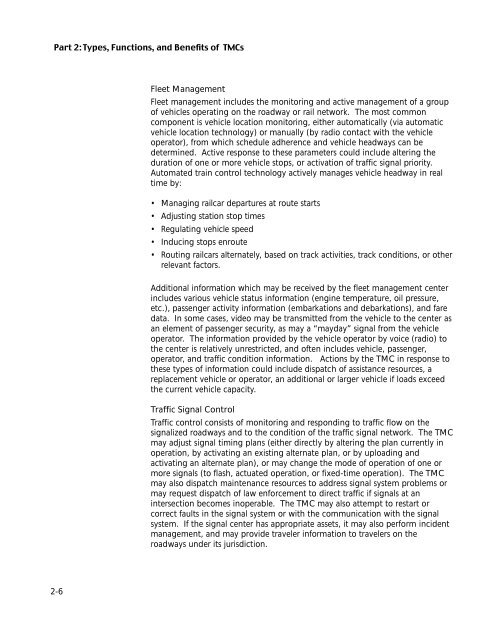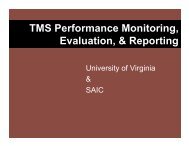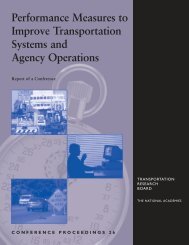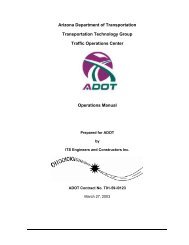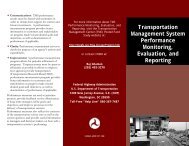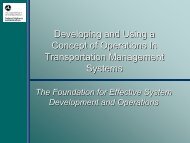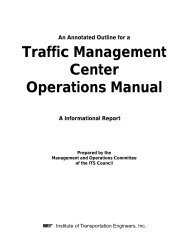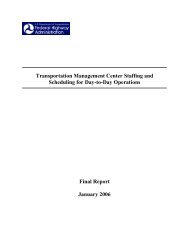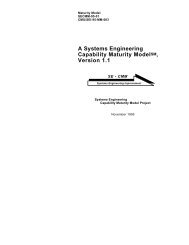Fleet <strong>Management</strong>Fleet management includes the monitoring and active management <strong>of</strong> a group<strong>of</strong> vehicles operating on the roadway or rail network. The most commoncomponent is vehicle location monitoring, either automatically (via automaticvehicle location technology) or manually (by radio contact with the vehicleoperator), from which schedule adherence and vehicle headways can bedetermined. Active response to these parameters could include altering theduration <strong>of</strong> one or more vehicle stops, or activation <strong>of</strong> traffic signal priority.Automated train control technology actively manages vehicle headway in realtime by:• Managing railcar departures at route starts• Adjusting station stop times• Regulating vehicle speed• Inducing stops enroute• Routing railcars alternately, based on track activities, track conditions, or otherrelevant factors.Additional information which may be received by the fleet management centerincludes various vehicle status information (engine temperature, oil pressure,etc.), passenger activity information (embarkations and debarkations), and faredata. In some cases, video may be transmitted from the vehicle to the center asan element <strong>of</strong> passenger security, as may a “mayday” signal from the vehicleoperator. The information provided by the vehicle operator by voice (radio) tothe center is relatively unrestricted, and <strong>of</strong>ten includes vehicle, passenger,operator, and traffic condition information. Actions by the TMC in response tothese types <strong>of</strong> information could include dispatch <strong>of</strong> assistance resources, areplacement vehicle or operator, an additional or larger vehicle if loads exceedthe current vehicle capacity.Traffic Signal ControlTraffic control consists <strong>of</strong> monitoring and responding to traffic flow on thesignalized roadways and to the condition <strong>of</strong> the traffic signal network. The TMCmay adjust signal timing plans (either directly by altering the plan currently inoperation, by activating an existing alternate plan, or by uploading andactivating an alternate plan), or may change the mode <strong>of</strong> operation <strong>of</strong> one ormore signals (to flash, actuated operation, or fixed-time operation). The TMCmay also dispatch maintenance resources to address signal system problems ormay request dispatch <strong>of</strong> law enforcement to direct traffic if signals at anintersection becomes inoperable. The TMC may also attempt to restart orcorrect faults in the signal system or with the communication with the signalsystem. If the signal center has appropriate assets, it may also perform incidentmanagement, and may provide traveler information to travelers on theroadways under its jurisdiction.2-6
System Control and DataAcquisitionSystem control and data acquisition(SCADA) functions are performed bymany TMCs, but are not specific tothe type <strong>of</strong> infrastructure managed.The best examples <strong>of</strong> SCADAfunctions are related to tunnels, andinclude:• Ventilation• Fire detection and suppression• Pumping• Electrical system control (load control, switching)• Security monitoring• Motorist telephone systemIn the Arizona TrailMaster TMC, SCADA functions also include control <strong>of</strong>irrigation in the highway medians. Another type <strong>of</strong> SCADA function, at theBoston Central Artery/Tunnel Integrated Project Control System, is AM/FMrebroadcast.<strong>Center</strong>-to-<strong>Center</strong> CoordinationCross-center coordination begins not when the center is operational, but duringinitial planning, design, and implementation. Involving all agencies active in thesituations addressed by the TMC ensures that the center is optimally configured,equipped, and staffed to achieve full benefit from the taxpayer investment.Ideally, the concept <strong>of</strong> operations will reflect the actions and methods <strong>of</strong> eachpartner in transportation management, and will reflect the resources andcapabilities necessary to achieve the chosen operational method.Information SharingThe focus <strong>of</strong> cross-center coordination is the sharing <strong>of</strong> information. Typicalexamples <strong>of</strong> infrastructure-based information sharing include messages onvariable message signs and highway advisory radio. Non-infrastructure intensivetraveler information includes provision <strong>of</strong> information via broadcast media,press, Internet, telephone systems, or via fax.Information sharing may occur at any time, i.e., as part <strong>of</strong> event planning,during an event, or following the event as a “post mortem” evaluation. In eventplanning, agencies should work to comprehensively detail the actions to beperformed, identifying who is responsible for each action, and how informationwill flow during the event. During the event itself, sharing information on whatis transpiring and how, and on how each agency is responding adds to the totaleffectiveness. In a post-event analysis, careful consideration <strong>of</strong> how the event2-7
- Page 1 and 2: Transportation ManagementCenterConc
- Page 3 and 4: Executive SummaryPart 1 Introductio
- Page 5 and 6: Agencies responsible for managing l
- Page 7 and 8: Focus of theDocumentPurposeThe purp
- Page 9 and 10: • The Systems• Operational Faci
- Page 11 and 12: WhatChallengesDo TMC’sFace?The mo
- Page 13 and 14: The concept of operation should doc
- Page 15 and 16: This section defines the types of t
- Page 17 and 18: Following notification, incidents a
- Page 19: Many fine examples of transit manag
- Page 23 and 24: The Contextof aConcept ofOperations
- Page 25: Where Does the Concept of Operation
- Page 28 and 29: Other Regional Impacts to Operation
- Page 31 and 32: An important element of jurisdictio
- Page 33 and 34: IntroductionThe concept of operatio
- Page 35 and 36: The concept of operation should als
- Page 37 and 38: At some point in the process, the r
- Page 39 and 40: Main> MBCommand-Based InterfaceMenu
- Page 41: Western MDTraffic OperationsCenterG
- Page 44 and 45: Field Device Examples• The TMC in
- Page 46 and 47: OperationalFacilityNeedsThere are m
- Page 48 and 49: Needs or Desires IdentifiedThe conc
- Page 50 and 51: The City of Los Angeles ATSAC Cente
- Page 52 and 53: At ATSAC, new hardware, devices, an
- Page 54 and 55: Less pleasant, although sometimes i
- Page 56 and 57: Deciding Whether/How to Share Contr
- Page 58 and 59: Caltrans and the California Highway
- Page 60 and 61: een compiled during the shift. Such
- Page 62 and 63: High level measures may include the
- Page 64 and 65: Example OrganizationDOT District En
- Page 66 and 67: Although ITE has established a reco
- Page 68 and 69: Los Angeles’ ATSAC Traffic Operat
- Page 70 and 71:
Staff Cross-TrainingCross-training,
- Page 72 and 73:
are needed will conclude by identif
- Page 74 and 75:
How Process Improvements Are MadeSi
- Page 76 and 77:
The concept of operations deals wit
- Page 78 and 79:
This communication can take place i
- Page 80 and 81:
The potential cost of configuration
- Page 82 and 83:
• The beginning of a task- Change
- Page 84 and 85:
need to address, if possible, the c
- Page 86 and 87:
Process Improvement Maintenance, as
- Page 88 and 89:
The training material is typically
- Page 90 and 91:
identifying the core documents (inc
- Page 92 and 93:
OperationalProcurementandContractin
- Page 94 and 95:
communications, heating/ventilation
- Page 96 and 97:
• Consulting The TMC may find tha
- Page 98 and 99:
• Standard agency payment process
- Page 100 and 101:
Human Factors GuidelinesThe Georgia
- Page 102 and 103:
How Can IFind OutMore AboutConcepts
- Page 104 and 105:
References1 Booz·Allen & Hamilton
- Page 106 and 107:
25 Institute of Transportation Engi
- Page 108 and 109:
For further information, contact:Fe
- Page 110:
INTELLIGENT TRANSPORTATION SYSTEMSU


